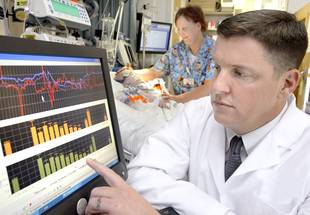|
|
||
| Patient monitoring | ||
Automated blood-flow monitoring may help prevent brain damage10 September 2007 Researchers from the Johns Hopkins Children’s Center in the US and Cambridge University in England have designed a system to track potentially dangerous changes in blood flow to the brain in real time. It shows promise for preventing brain damage and death in children with head injuries. Healthy brains regulate blood flow and oxygen levels during drops and spikes in blood pressure, but injured brains may lose this fail-safe mechanism, leading to oxygen starvation and permanent brain damage. Although monitors have long been able to track blood pressure and blood flow to the brain, the Hopkins–Cambridge team created a system that for the first time precisely determines the 'breakpoint' at which the brain begins to lose its ability to cope with changes in blood pressure. The software does this by gauging minute shifts in blood pressure and oxygenation every 60 seconds and alerting doctors when they approach critical levels.
“More tests are needed, but we have demonstrated the value of gathering much more detailed information over time about what safe levels of pressure and oxygen are in children,” says Ken Brady, MD, a critical-care specialist at the Children’s Center who led the study. “Despite our ability to monitor pressure and oxygen levels, we have desperately needed more information about what are optimal levels for damage prevention in children,” Brady says. “Not knowing that is much like flying a plane in a fog, but this new software is helping us map safe terrain and danger zones in blood pressure.”
Using software developed by two Cambridge scientists, Hopkins doctors fed
data into a computer from two staples of the paediatric intensive care unit
— an old-fashioned arterial blood pressure monitor and an oxygen meter that
uses beams of infrared light to estimate oxygen saturation in the brain. “This intricate interplay between oxygenation and blood flow was the big unknown in what is indeed a simple equation, and now we’ve pinpointed the level where arterial blood pressure needs to be in order to promote healing in the injured brain,” Brady says. In traumatic brain injuries, some brain damage occurs on impact, but much damage and indeed many deaths occur in the critical two-to-five-day window following the injury, a critical time when brain function must be monitored to ward off damage. This is when and where the new system will be most useful, researchers say. The technique could be also used in premature babies, who are particularly prone to ischemic strokes and bleeding in the brain because of their brains’ immature self-regulatory mechanisms and their fragile blood vessels. A report on the research, including results of preliminary testing in baby pigs, will appear in the October issue of Stroke.
|
